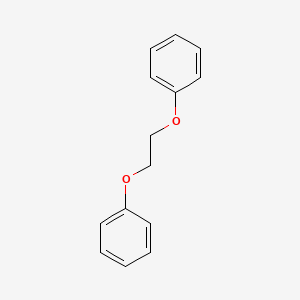
Antioxidant BHT 264
CAS:128-37-0
Purity:99%
Contact Now
We will contact you as soon as possible
Your Location:Home >Products >Thermal Paper Chemicals >104-66-5


Product Details
|
Chemical Properties |
Off-white Crystals |
|
Uses |
Diphenoxyethane (DPE), also known as 1,2-diphenoxyethane, ethylene glycol diphenyl ether, 2-phenoxyethoxybenzene, and ethane, 1,2-diphenoxy-, can be used as a heat-sensitive material sensitizer and as a potential additive to polyolefin catalysts. |
|
Preparation |
DPE is as follows:A three-necked flask was charged with 15.7 g of bromobenzene (100 mmol) and 47 ml of DMF, and stirred. 12.7 g of sodium carbonate (120 mmol, 1.2 eq.), 1.9 g of cuprous iodide (10 mmol, 0.1 eq.), 1.87 g of 2,2'-bipyridine (12 mmol, 0.1 eq.) and 7.4 g of ethylene glycol (120 mmol, 1.2 equivalent), the reaction mixture was stirred at 100 ° C overnight. After recovering DMF under reduced pressure, 100 ml of water and 100 ml of toluene were added, and the aqueous phase was extracted three times with 300 ml of toluene, and the organic layers were combined. Washed sequentially with 5% sodium carbonate. The organic phase was dried over anhydrous sodium sulfate, filtered, and then filtered and evaporated,The crude product was recrystallized from isopropanol and dried in vacuo to give 19.5 g of product, yield 91%, purity over 99%. |
|
General Description |
DPE is an intermediate that forms during the sonochemical oxidation of chlorophenol and phenoxyacetic acid. DPE (C6H5–O–CH2–CH2–O–C6H5, DPOE) is a flexible bichromophore in which the two phenyl rings are separated from one another by an −O–CH2–CH2–O– chain with five flexible dihedral angles about which hindered rotation can occur. As such, it is a phenyl capped analog of dimethoxyethane (DMOE), which has served as a model compound for development of force fields for polyethylene glycol (PEG). |
|
Flammability and Explosibility |
Nonflammable |
|
Consumer Uses |
ECHA has no public registered data indicating whether or in which chemical products the substance might be used. Other release to the environment of this substance is likely to occur from: indoor use as processing aid. |
InChI:InChI=1/C14H14O2/c1-3-7-13(8-4-1)15-11-12-16-14-9-5-2-6-10-14/h1-10H,11-12H2
The geometry changes of the tgt- and the ttt-rotamer of 1,2-diphenoxyethane were determined from a combined fit of line intensities in fluorescence emission spectra, obtained via pumping different vibronic transition, and the changes of rotational constants upon electronic excitation, which were taken from [E.G. Buchanan, P.S. Walsh, D.F. Plusquellic, T.S. Zwier, J. Chem. Phys. 138 (2013) 204313]. The so determined geometry changes are compared to the results of ab initio spin-component-scaled approximate coupled cluster singles and doubles (SCS-CC2) calculations.
Several ethylenedioxy-bridged bisarenes ...
Electron-rich aryl bromides are rapidly ...
The invention relates to a thermo-sensit...
The presence of the oxygen atoms in the chain shifts the CH scissor overtones to higher frequencies than in pure alkyl chains, qualitatively changing the spectral consequences of the Fermi resonance, with the scissor overtones now appearing as the highest frequency bands in the spectrum. The spectra are contrasted with those in 1,2-diphenylethane, a close analog with a very different appearance to its CH stretch spectrum, in which the scissor overtones appear as the lowest frequency bands.
sodium phenoxide

ethylene dibromide

1,2-diphenoxyethane

phenoxyethyl bromide
| Conditions | Yield |
|---|---|
|
With ethanol;
|
ethanol

ethylene dibromide

phenol

1,2-diphenoxyethane

phenoxyethyl bromide
| Conditions | Yield |
|---|---|
|
Reaktion von Natriumphenolat;
|
potassium phenolate
sodium phenoxide
1,2-dichloro-ethane
ethanol
2,4-Dinitrophenol
1,2-bis(4-nitrophenoxy)ethane
1,2-bis(4-formylphenoxy)ethane
4,4'-(ethylenedioxy)dibromobenzene